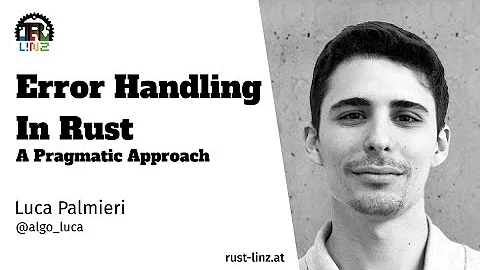What are Rust's exact auto-dereferencing rules?
Solution 1
Your pseudo-code is pretty much correct. For this example, suppose we had a method call foo.bar() where foo: T. I'm going to use the fully qualified syntax (FQS) to be unambiguous about what type the method is being called with, e.g. A::bar(foo) or A::bar(&***foo). I'm just going to write a pile of random capital letters, each one is just some arbitrary type/trait, except T is always the type of the original variable foo that the method is called on.
The core of the algorithm is:
- For each "dereference step"
U(that is, setU = Tand thenU = *T, ...)- if there's a method
barwhere the receiver type (the type ofselfin the method) matchesUexactly , use it (a "by value method") - otherwise, add one auto-ref (take
&or&mutof the receiver), and, if some method's receiver matches&U, use it (an "autorefd method")
- if there's a method
Notably, everything considers the "receiver type" of the method, not the Self type of the trait, i.e. impl ... for Foo { fn method(&self) {} } thinks about &Foo when matching the method, and fn method2(&mut self) would think about &mut Foo when matching.
It is an error if there's ever multiple trait methods valid in the inner steps (that is, there can be only be zero or one trait methods valid in each of 1. or 2., but there can be one valid for each: the one from 1 will be taken first), and inherent methods take precedence over trait ones. It's also an error if we get to the end of the loop without finding anything that matches. It is also an error to have recursive Deref implementations, which make the loop infinite (they'll hit the "recursion limit").
These rules seem to do-what-I-mean in most circumstances, although having the ability to write the unambiguous FQS form is very useful in some edge cases, and for sensible error messages for macro-generated code.
Only one auto-reference is added because
- if there was no bound, things get bad/slow, since every type can have an arbitrary number of references taken
- taking one reference
&fooretains a strong connection tofoo(it is the address offooitself), but taking more starts to lose it:&&foois the address of some temporary variable on the stack that stores&foo.
Examples
Suppose we have a call foo.refm(), if foo has type:
-
X, then we start withU = X,refmhas receiver type&..., so step 1 doesn't match, taking an auto-ref gives us&X, and this does match (withSelf = X), so the call isRefM::refm(&foo) -
&X, starts withU = &X, which matches&selfin the first step (withSelf = X), and so the call isRefM::refm(foo) -
&&&&&X, this doesn't match either step (the trait isn't implemented for&&&&Xor&&&&&X), so we dereference once to getU = &&&&X, which matches 1 (withSelf = &&&X) and the call isRefM::refm(*foo) -
Z, doesn't match either step so it is dereferenced once, to getY, which also doesn't match, so it's dereferenced again, to getX, which doesn't match 1, but does match after autorefing, so the call isRefM::refm(&**foo). -
&&A, the 1. doesn't match and neither does 2. since the trait is not implemented for&A(for 1) or&&A(for 2), so it is dereferenced to&A, which matches 1., withSelf = A
Suppose we have foo.m(), and that A isn't Copy, if foo has type:
-
A, thenU = Amatchesselfdirectly so the call isM::m(foo)withSelf = A -
&A, then 1. doesn't match, and neither does 2. (neither&Anor&&Aimplement the trait), so it is dereferenced toA, which does match, butM::m(*foo)requires takingAby value and hence moving out offoo, hence the error. -
&&A, 1. doesn't match, but autorefing gives&&&A, which does match, so the call isM::m(&foo)withSelf = &&&A.
(This answer is based on the code, and is reasonably close to the (slightly outdated) README. Niko Matsakis, the main author of this part of the compiler/language, also glanced over this answer.)
Solution 2
The Rust reference has a chapter about the method call expression. I copied the most important part below. Reminder: we are talking about an expression recv.m(), where recv is called "receiver expression" below.
The first step is to build a list of candidate receiver types. Obtain these by repeatedly dereferencing the receiver expression's type, adding each type encountered to the list, then finally attempting an unsized coercion at the end, and adding the result type if that is successful. Then, for each candidate
T, add&Tand&mut Tto the list immediately afterT.For instance, if the receiver has type
Box<[i32;2]>, then the candidate types will beBox<[i32;2]>,&Box<[i32;2]>,&mut Box<[i32;2]>,[i32; 2](by dereferencing),&[i32; 2],&mut [i32; 2],[i32](by unsized coercion),&[i32], and finally&mut [i32].Then, for each candidate type
T, search for a visible method with a receiver of that type in the following places:
T's inherent methods (methods implemented directly onT[¹]).- Any of the methods provided by a visible trait implemented by
T. [...]
(Note about [¹]: I actually think this phrasing is wrong. I've opened an issue. Let's just ignore that sentence in the parenthesis.)
Let's go through a few examples from your code in detail! For your examples, we can ignore the part about "unsized coercion" and "inherent methods".
(*X{val:42}).m(): the receiver expression's type is i32. We perform these steps:
- Creating list of candidate receiver types:
-
i32cannot be dereferenced, so we are already done with step 1. List:[i32] - Next, we add
&i32and&mut i32. List:[i32, &i32, &mut i32]
-
- Searching for methods for each candidate receiver type:
- We find
<i32 as M>::mwhich has the receiver typei32. So we are already done.
- We find
So far so easy. Now let's pick a more difficult example: (&&A).m(). The receiver expression's type is &&A. We perform these steps:
- Creating list of candidate receiver types:
-
&&Acan be dereferenced to&A, so we add that to the list.&Acan be dereferenced again, so we also addAto the list.Acannot be dereferenced, so we stop. List:[&&A, &A, A] - Next, for each type
Tin the list, we add&Tand&mut Timmediately afterT. List:[&&A, &&&A, &mut &&A, &A, &&A, &mut &A, A, &A, &mut A]
-
- Searching for methods for each candidate receiver type:
- There is no method with receiver type
&&A, so we go to the next type in the list. - We find the method
<&&&A as M>::mwhich indeed has the receiver type&&&A. So we are done.
- There is no method with receiver type
Here are the candidate receiver lists for all of your examples. The type that is enclosed in ⟪x⟫ is the one that "won", i.e. the first type for which a fitting method could be found. Also remember that the first type in the list is always the receiver expression's type. Lastly, I formatted the list in lines of three, but that's just formatting: this list is a flat list.
-
(*X{val:42}).m()→<i32 as M>::m[⟪i32⟫, &i32, &mut i32] -
X{val:42}.m()→<X as M>::m[⟪X⟫, &X, &mut X, i32, &i32, &mut i32] -
(&X{val:42}).m()→<&X as M>::m[⟪&X⟫, &&X, &mut &X, X, &X, &mut X, i32, &i32, &mut i32] -
(&&X{val:42}).m()→<&&X as M>::m[⟪&&X⟫, &&&X, &mut &&X, &X, &&X, &mut &X, X, &X, &mut X, i32, &i32, &mut i32] -
(&&&X{val:42}).m()→<&&&X as M>::m[⟪&&&X⟫, &&&&X, &mut &&&X, &&X, &&&X, &mut &&X, &X, &&X, &mut &X, X, &X, &mut X, i32, &i32, &mut i32] -
(&&&&X{val:42}).m()→<&&&X as M>::m[&&&&X, &&&&&X, &mut &&&&X, ⟪&&&X⟫, &&&&X, &mut &&&X, &&X, &&&X, &mut &&X, &X, &&X, &mut &X, X, &X, &mut X, i32, &i32, &mut i32] -
(&&&&&X{val:42}).m()→<&&&X as M>::m[&&&&&X, &&&&&&X, &mut &&&&&X, &&&&X, &&&&&X, &mut &&&&X, ⟪&&&X⟫, &&&&X, &mut &&&X, &&X, &&&X, &mut &&X, &X, &&X, &mut &X, X, &X, &mut X, i32, &i32, &mut i32]
-
(*X{val:42}).refm()→<i32 as RefM>::refm[i32, ⟪&i32⟫, &mut i32] -
X{val:42}.refm()→<X as RefM>::refm[X, ⟪&X⟫, &mut X, i32, &i32, &mut i32] -
(&X{val:42}).refm()→<X as RefM>::refm[⟪&X⟫, &&X, &mut &X, X, &X, &mut X, i32, &i32, &mut i32] -
(&&X{val:42}).refm()→<&X as RefM>::refm[⟪&&X⟫, &&&X, &mut &&X, &X, &&X, &mut &X, X, &X, &mut X, i32, &i32, &mut i32] -
(&&&X{val:42}).refm()→<&&X as RefM>::refm[⟪&&&X⟫, &&&&X, &mut &&&X, &&X, &&&X, &mut &&X, &X, &&X, &mut &X, X, &X, &mut X, i32, &i32, &mut i32] -
(&&&&X{val:42}).refm()→<&&&X as RefM>::refm[⟪&&&&X⟫, &&&&&X, &mut &&&&X, &&&X, &&&&X, &mut &&&X, &&X, &&&X, &mut &&X, &X, &&X, &mut &X, X, &X, &mut X, i32, &i32, &mut i32] -
(&&&&&X{val:42}).refm()→<&&&X as RefM>::refm[&&&&&X, &&&&&&X, &mut &&&&&X, ⟪&&&&X⟫, &&&&&X, &mut &&&&X, &&&X, &&&&X, &mut &&&X, &&X, &&&X, &mut &&X, &X, &&X, &mut &X, X, &X, &mut X, i32, &i32, &mut i32]
-
Y{val:42}.refm()→<i32 as RefM>::refm[Y, &Y, &mut Y, i32, ⟪&i32⟫, &mut i32] -
Z{val:Y{val:42}}.refm()→<i32 as RefM>::refm[Z, &Z, &mut Z, Y, &Y, &mut Y, i32, ⟪&i32⟫, &mut i32]
-
A.m()→<A as M>::m[⟪A⟫, &A, &mut A] -
(&A).m()→<A as M>::m[&A, &&A, &mut &A, ⟪A⟫, &A, &mut A] -
(&&A).m()→<&&&A as M>::m[&&A, ⟪&&&A⟫, &mut &&A, &A, &&A, &mut &A, A, &A, &mut A] -
(&&&A).m()→<&&&A as M>::m[⟪&&&A⟫, &&&&A, &mut &&&A, &&A, &&&A, &mut &&A, &A, &&A, &mut &A, A, &A, &mut A] -
A.refm()→<A as RefM>::refm[A, ⟪&A⟫, &mut A] -
(&A).refm()→<A as RefM>::refm[⟪&A⟫, &&A, &mut &A, A, &A, &mut A] -
(&&A).refm()→<A as RefM>::refm[&&A, &&&A, &mut &&A, ⟪&A⟫, &&A, &mut &A, A, &A, &mut A] -
(&&&A).refm()→<&&&A as RefM>::refm[&&&A, ⟪&&&&A⟫, &mut &&&A, &&A, &&&A, &mut &&A, &A, &&A, &mut &A, A, &A, &mut A]
Related videos on Youtube
kFYatek
Updated on July 08, 2022Comments
-
kFYatek almost 2 years
I'm learning/experimenting with Rust, and in all the elegance that I find in this language, there is one peculiarity that baffles me and seems totally out of place.
Rust automatically dereferences pointers when making method calls. I made some tests to determine the exact behaviour:
struct X { val: i32 } impl std::ops::Deref for X { type Target = i32; fn deref(&self) -> &i32 { &self.val } } trait M { fn m(self); } impl M for i32 { fn m(self) { println!("i32::m()"); } } impl M for X { fn m(self) { println!("X::m()"); } } impl M for &X { fn m(self) { println!("&X::m()"); } } impl M for &&X { fn m(self) { println!("&&X::m()"); } } impl M for &&&X { fn m(self) { println!("&&&X::m()"); } } trait RefM { fn refm(&self); } impl RefM for i32 { fn refm(&self) { println!("i32::refm()"); } } impl RefM for X { fn refm(&self) { println!("X::refm()"); } } impl RefM for &X { fn refm(&self) { println!("&X::refm()"); } } impl RefM for &&X { fn refm(&self) { println!("&&X::refm()"); } } impl RefM for &&&X { fn refm(&self) { println!("&&&X::refm()"); } } struct Y { val: i32 } impl std::ops::Deref for Y { type Target = i32; fn deref(&self) -> &i32 { &self.val } } struct Z { val: Y } impl std::ops::Deref for Z { type Target = Y; fn deref(&self) -> &Y { &self.val } } #[derive(Clone, Copy)] struct A; impl M for A { fn m(self) { println!("A::m()"); } } impl M for &&&A { fn m(self) { println!("&&&A::m()"); } } impl RefM for A { fn refm(&self) { println!("A::refm()"); } } impl RefM for &&&A { fn refm(&self) { println!("&&&A::refm()"); } } fn main() { // I'll use @ to denote left side of the dot operator (*X{val:42}).m(); // i32::m() , Self == @ X{val:42}.m(); // X::m() , Self == @ (&X{val:42}).m(); // &X::m() , Self == @ (&&X{val:42}).m(); // &&X::m() , Self == @ (&&&X{val:42}).m(); // &&&X:m() , Self == @ (&&&&X{val:42}).m(); // &&&X::m() , Self == *@ (&&&&&X{val:42}).m(); // &&&X::m() , Self == **@ println!("-------------------------"); (*X{val:42}).refm(); // i32::refm() , Self == @ X{val:42}.refm(); // X::refm() , Self == @ (&X{val:42}).refm(); // X::refm() , Self == *@ (&&X{val:42}).refm(); // &X::refm() , Self == *@ (&&&X{val:42}).refm(); // &&X::refm() , Self == *@ (&&&&X{val:42}).refm(); // &&&X::refm(), Self == *@ (&&&&&X{val:42}).refm(); // &&&X::refm(), Self == **@ println!("-------------------------"); Y{val:42}.refm(); // i32::refm() , Self == *@ Z{val:Y{val:42}}.refm(); // i32::refm() , Self == **@ println!("-------------------------"); A.m(); // A::m() , Self == @ // without the Copy trait, (&A).m() would be a compilation error: // cannot move out of borrowed content (&A).m(); // A::m() , Self == *@ (&&A).m(); // &&&A::m() , Self == &@ (&&&A).m(); // &&&A::m() , Self == @ A.refm(); // A::refm() , Self == @ (&A).refm(); // A::refm() , Self == *@ (&&A).refm(); // A::refm() , Self == **@ (&&&A).refm(); // &&&A::refm(), Self == @ }So, it seems that, more or less:
- The compiler will insert as many dereference operators as necessary to invoke a method.
- The compiler, when resolving methods declared using
&self(call-by-reference):- First tries calling for a single dereference of
self - Then tries calling for the exact type of
self - Then, tries inserting as many dereference operators as necessary for a match
- First tries calling for a single dereference of
- Methods declared using
self(call-by-value) for typeTbehave as if they were declared using&self(call-by-reference) for type&Tand called on the reference to whatever is on the left side of the dot operator. - The above rules are first tried with raw built-in dereferencing, and if there's no match, the overload with
Dereftrait is used.
What are the exact auto-dereferencing rules? Can anyone give any formal rationale for such a design decision?
-
 Shepmaster over 9 yearsI've cross-posted this to the Rust subreddit in the hopes of getting some good answers!
Shepmaster over 9 yearsI've cross-posted this to the Rust subreddit in the hopes of getting some good answers! -
user2665887 over 9 yearsFor extra fun try to repeat the experiment in generics and compare the results.
-
 Lii over 6 yearsThis answer seems exhaustive and detailed but I think it lacks a short and accessible summery of the rules. One such summery is given in this comment by Shepmaster: "It [the deref algorithm] will deref as many times as possible (
Lii over 6 yearsThis answer seems exhaustive and detailed but I think it lacks a short and accessible summery of the rules. One such summery is given in this comment by Shepmaster: "It [the deref algorithm] will deref as many times as possible (&&String->&String->String->str) and then reference at max once (str->&str)". -
 Lii over 6 years(I don't know how accurate and complete that explanation is myself.)
Lii over 6 years(I don't know how accurate and complete that explanation is myself.) -
 Lii almost 6 yearsIn what cases do auto dereferencing occur? Is it used only for the receiver expression for method call? For field accesses also? Assignment right-hand sides? Left-hand sides? Function parameters? Return value expressions?
Lii almost 6 yearsIn what cases do auto dereferencing occur? Is it used only for the receiver expression for method call? For field accesses also? Assignment right-hand sides? Left-hand sides? Function parameters? Return value expressions? -
SamB over 5 yearsNote: Currently, the nomicon has a TODO note to steal information from this answer and write it up in static.rust-lang.org/doc/master/nomicon/dot-operator.html
-
haslersn over 5 yearsIs coercion (A) tried before this or (B) tried after this or (C) tried in every step of this algorithm or (D) something else?
-
Xiao-Feng Li over 4 years@haslersn Auto deref is part of coercion, which includes auto-deref, auto-unsize, auto-ref, etc. See the implementation code here: github.com/rust-lang/rust/blob/…. Auto-unsize is applied after one or more auto-derefs, and auto-ref is after other adjustments. So per you specific question, (C) tried in every step is the answer.
-
Joseph Garvin almost 4 yearsNotably this coercion does not appear to happen for comparison operators like
>, inconsistent with named function calls.













